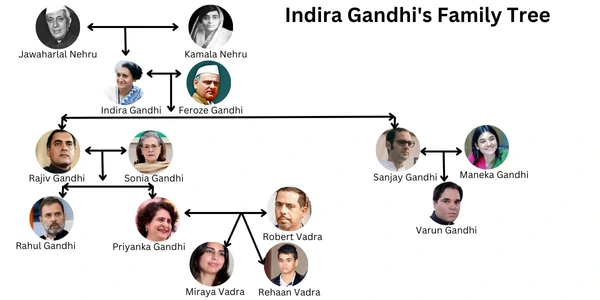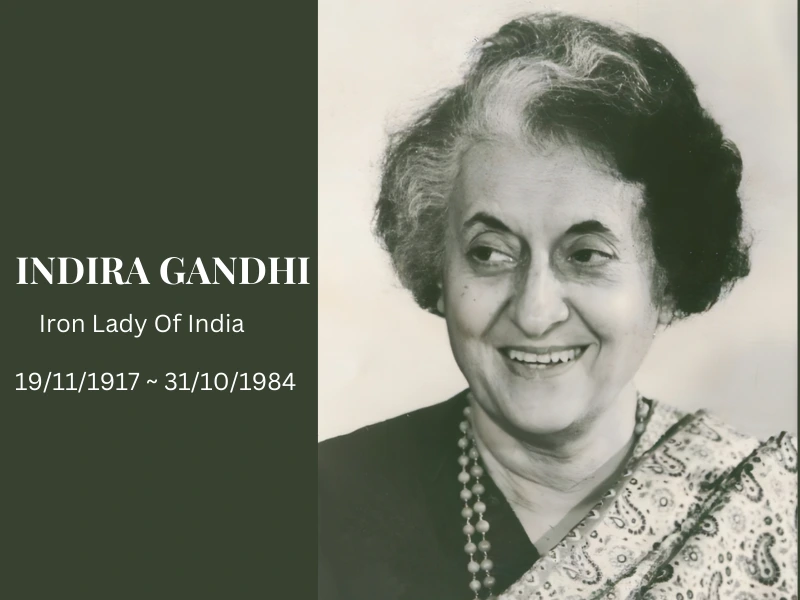It was during her age that Indira Gandhi became India’s first female prime minister and one of the few who have experienced such a long term in office. She took upon her stalwart leadership to take difficult decisions that made her stand tall at the core of India’s political culture in the 20th century. She spent 15 years in office as Prime Minister and is etched in history as one of the most impactful personalities ever.
Personal Information
| Full Name | Indira Priyadarshini Nehru |
| Born | 19 November 1917 |
| Education | Visva-Bharati University Somerville College, Oxford |
| Political party | Indian National Congress (1938–1969) Congress (R) (1969–1978) Congress (I) (1978–1984) |
| Spouse | Feroze Gandhi |
| Children | Rajiv Gandhi (son) Sanjay Gandhi (son) |
| Parent(s) | Jawaharlal Nehru (father) Kamala Nehru (mother) |
| Nicknames | Iron Lady, Durga |
| Died | 31 October 1984 |
| Notable Awards | Bharat Ratna (1971) |
Early Life and Family Background
Born on 19 November 1917 in Allahabad, India, she was the only child of Jawaharlal Nehru, who would one day become the first Prime Minister of India, and Kamala Nehru. Her childhood was spent within a charged political atmosphere, for Jawaharlal had been an early starter in the Indian independence movement.
Education and Political Influence
Studying in India and Abroad
Indira went through different schools in India, including Shantiniketan, under the tutelage of Rabindranath Tagore, and later to Oxford University in England. Her stay abroad made her gain this attitude and proved her more aware of politics as well as of the international scenario.
Influence of Jawaharlal Nehru
Being the daughter of one of the premier leaders who fought for India’s independence, Jawaharlal Nehru, it was impossible that Indira did not know her father’s ideologies and philosophy of politics. That life prepared her for a future in Indian politics.
Marriage and Family Life
She married Feroze Gandhi in 1942—a freedom fighter and a journalist. Two sons: Rajiv Gandhi and Sanjay Gandhi; Sanjay was extremely influential in Indian politics. Meantime, Feroze Gandhi died in 1960, which eased all restrictions for Indira to wholly concentrate on her political career.
Indira Gandhi Family Tree
Here’s a simplified family tree of Indira Gandhi:
Indira Gandhi’s Family Tree
1. Parents:
- Jawaharlal Nehru (Father): First Prime Minister of India
- Kamala Nehru (Mother): Activist in India’s independence movement
2. Siblings:
- Vijaya Lakshmi Pandit: Diplomat and politician; first woman to serve as the President of the United Nations General Assembly.
3. Spouse:
- Feroze Gandhi (married in 1942): Journalist and politician.
4. Children:
- Rajiv Gandhi (1944-1991): Prime Minister of India (1984-1989).
- Sonia Gandhi (married in 1968): Italian-born Indian politician.
- Children:
- Rahul Gandhi: Indian politician, former president of the Indian National Congress.
- Priyanka Gandhi Vadra: Indian politician and General Secretary of the Indian National Congress.
- Children:
- Sonia Gandhi (married in 1968): Italian-born Indian politician.
- Sanjay Gandhi (1946-1980): Politician, known for his controversial role during the Emergency period.
- Maneka Gandhi: Politician. The daughter-in-law of Indira Gandhi and the wife of Sanjay Gandhi
- Children : Varun Gandhi: Politician. The son of Sanjay Gandhi and Maneka Gandhi.
- Maneka Gandhi: Politician. The daughter-in-law of Indira Gandhi and the wife of Sanjay Gandhi
Grandchildren:
- Rahul Gandhi’s Children: None
- Priyanka Gandhi’s Children:
- Miraya Vadra
- Rehaan Vadra

This family tree highlights Indira Gandhi’s immediate family and her significant contributions to Indian politics through her lineage.
Indira Gandhi’s Entry into Politics
Indira Gandhi first entered political life through formal doors in the 1950s by accompanying her father, who, at that time, was Prime Minister of India. In 1964, following the death of Nehru, she was appointed the Minister of Information and Broadcasting. So, it marked her entry into service within the Indian government.
Becoming Prime Minister of India
First Term as Prime Minister
Mrs. Gandhi was India’s prime minister just a few months after the nation was shocked by the death of Prime Minister Lal Bahadur Shastri in 1966. More of a figurehead at first hailed, she soon established herself as a force for a nation heavy with grief at the loss of her father.
Major Reforms and Policies
During the period of her first term, Indira Gandhi initiated several economic and social reforms, such as nationalization of the banks and industrialization programs. Her policies were in the direction of removing poverty and building a self-dependent India.
Indira Gandhi’s Role in the 1971 War
She took India through the Indo-Pakistani War in 1971 that, finally, ended with the formation of Bangladesh. In this war, Indira Gandhi proved to be a decisive leader, as she won the day not only for India but for the entire Third World. She was appreciated everywhere around the world for handling the situation so cautiously.
The Green Revolution and Agricultural Reforms
She ushered in the Green Revolution, one of the landmark contributions India made under her leadership, which had really turned the face of Indian agriculture. Now, modern farming methods and progress in irrigation brought the country to self-sufficiency in food production and even reduced imports to virtually next to negligible.
The Emergency Period (1975-1977)
Reasons for Declaring the Emergency
It was in 1975 that Indira Gandhi declared a state of emergency in India. Politicians and growing opposition forces had brought the country to the mercy of political unrest, and Indira Gandhi used this to declare a state of emergency, which gave her government sweeping powers, including suspending civil liberties and imprisoning political opponents.
Impact of the Emergency on India
The Emergency period between 1975 and 1977 was probably the most controversial time period in the political tenure of Indira Gandhi. It provided allowance for reforms to take place and gave her a golden opportunity to change the system, but it was severely criticized for authoritarian measures followed by it.
Also read Sardar Vallabhbhai Patel Biography
Return to Power in 1980
After her defeat in the elections in 1977, Indira Gandhi again returned to politics to become elected Prime Minister of India for the third time in 1980. Her tenure was scarred by major issues of internal security, the Khalistan movement in Punjab being one of them.
Assassination and Aftermath
Indira Gandhi was assassinated on October 31, 1984, by her own bodyguards due to the military action she led in Operation Blue Star, a military assault against Sikh militants occupying the Golden Temple. In the days following her death, violence and rioting swept across much of India.
Indira Gandhi’s Legacy in Indian Politics
There is, however, the common characteristic of many Indians—that Indira Gandhi is generally regarded as a great leader, whose time of governance changed India. Several people love her decisiveness; she made stern decisions while being opposed during those times. She may well be surrounded by controversies over her name, but she is still credited for what can be regarded as a contribution to the growth and development of India.
Awards and Recognition
Indira Gandhi won many awards and honors during her lifetime, such as the Bharat Ratna in 1971, which is India’s greatest civilian honor. Her administration during the Bangladesh War and her initiatives toward the modernization of the Indian economy received considerable acclamation.
| Year | Decoration | Country |
| 1971 | Bharat Ratna | India |
| 1985 | Lenin Peace Prize | Soviet Union |
| 2011 | Bangladesh Freedom Honour | Bangladesh |
Challenges Faced by Indira Gandhi
Politically, she faced a few challenges in her tenure: political opposition and inner conflicts, along with economic troubles. While she had announced the emergency and touched upon the Punjab crisis with its negative state, it became one of the most controversial decisions of her life, but she emerged as a forceful figure to maintain control and unity in the country.
Conclusion: Indira Gandhi’s Impact on India
Indira Gandhi is the most significant figure in the history of Indian politics. As India’s first woman prime minister, she bridged a gap within the country and molded its future, but where policies were present, controversies accompanied them. Her contribution to the development of India’s economy as well as politics is undeniable. Indian women still look up to her as a role model, even so many years after her death.
FAQs
What was the cause of the death of Indira Gandhi?
Indira Gandhi, the Prime Minister of India, was assassinated on October 31, 1984, at 9:30 a.m. by her own Sikh bodyguards Satwant Singh and Beant Singh in retaliation for her role in ordering Operation Blue Star, a military operation targeting Sikh militants at the Golden Temple in Amritsar.
Why is Indira Gandhi famous?
Indira Gandhi is famous for being the first and only female Prime Minister of India, serving from 1966 to 1977 and again from 1980 until her assassination in 1984. She is known for her strong leadership, centralizing power, and significant political decisions like nationalizing banks and leading India to victory in the 1971 Indo-Pakistani War, which resulted in the creation of Bangladesh.
Why did Indira Gandhi marry Feroze Gandhi?
Indira Gandhi married Feroze Gandhi out of personal choice and love. They met while studying in the UK and shared similar political interests, especially their involvement in India’s independence movement. Despite opposition from her family and others due to different religious backgrounds (Indira was Hindu, and Feroze was Parsi), they married in 1942. Their union was driven by mutual affection and shared ideals.
Who defeated Indira Gandhi?
Indira Gandhi was defeated in the 1977 general elections by the Janata Party coalition, led by Morarji Desai, following widespread discontent over her imposition of the Emergency (1975-1977). In her own constituency of Rae Bareli, she lost to Raj Narain, a prominent opposition leader.




Valuable information. Lucky me I found your website by accident, and I am shocked why this accident did not happened earlier! I bookmarked it.
I’m not that much of a online reader to be honest but your blogs really nice, keep it up! I’ll go ahead and bookmark your site to come back down the road. Cheers